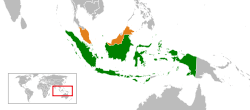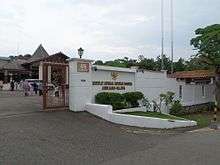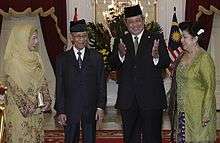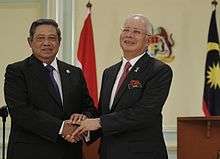Indonesia–Malaysia relations
 |
|
Indonesia |
Malaysia |
|---|---|

Indonesia–Malaysia relations are foreign bilateral relations between Indonesia and Malaysia, and it is one of the most important bilateral relationships in Southeast Asia.[1]
Indonesia and Malaysia are two neighbouring nations that shared similarities in many aspects.[2] Both Malaysia and Indonesia have many common characteristic traits, these include common frames of reference in history, culture and religion. Although both countries are separate and independent states, there are also deeply embedded similarities.[3] Their national languages; Indonesian language and Malaysian language are closely related and mutually intelligible, both being standardised registers of Malay. The majority of the population of both nations were of Austronesian ancestry or of the Malay race, with significant Malay culture shared among them. Both nations are Muslim majority countries, the founding members of ASEAN and APEC, and also members of the Non-aligned Movement, Developing 8 Countries and Organisation of Islamic Cooperation.
Despite sharing so many similarities, tied by common religion, language, proximity and a cultural heritage that dates back centuries, both nations have been lurching from one diplomatic spat to another.[4] Since independence Indonesia and Malaysia have moved in different directions in their social, economic, and political development, leading at times to serious bilateral tensions.[5] The unequal pace of democratisation in the two countries over last decades has made the relationship increasingly problematic. Malaysian government-controlled media has been restrained in reporting sensitive issues involving Indonesia, on the other hand Indonesia's liberal mass media has played a key role in inflaming the tension.[1]
Indonesia has an embassy in Kuala Lumpur and consulates general in Johor Bahru, George Town, Kota Kinabalu and Kuching. Malaysia has an embassy in Jakarta and a consulates general in Medan, Pekanbaru and Pontianak.[6]
Country comparison
| |
| |
|---|---|---|
| Population | 255,461,700[7] | 30,800,000[8] |
| Area | 1,904,569 km2 (735,358 sq mi) | 329,847 km2 (127,355 sq mi ) |
| Population Density | 124.66/km2 (322.87/sq mi) | 92/km2 (237/sq mi) |
| Time zones | 3 | 1 |
| Capital | Jakarta | Kuala Lumpur (Putrajaya is the seat of government) |
| Largest City | Jakarta – 11,374,022 (30,326,103 Metro) | Kuala Lumpur – 1,627,172 (7,200,000 Metro) |
| Government | Unitary presidential constitutional republic | Federal parliamentary constitutional monarchy |
| Official language | Indonesian (de facto and de jure) | Malaysian (de facto and de jure), English (de jure in some official purposes) |
| Recognised regional languages | Various | Various |
| Main religions | 87.2% Islam, 6.9% Protestantism, 2.9% Catholicism, 1.6% Hinduism, 0.72% Buddhism, 0.05% Confucianism, 0.5% Other | 61.3% Islam, 19.8% Buddhism, 9.2% Christianity, 6.3% Hinduism, 1.3% Confucianism/Taoism/Chinese folk religion, 1% No answer, 0.7% Atheism, 0.4% Other |
| Ethnic groups | 40.22% Javanese, 15.5% Sundanese, 3.58% Batak, 3.03% Madurese, 2.88% Betawi, 2.73% Minangkabau, 2.69% Bugis, 2.27% Malay, 1.97% Bantenese, 1.74% Banjar, 1.73% Acehnese, 1.67% Balinese, 1.34% Sasak, 1.27 Dayak, 1.2% Chinese, 1.14% Papuan, 1.13% Makassarese, 14.24% Other | 67.4% Malay, 24.6% Chinese, 7.3% Indian, 0.7% Other |
| GDP (per capita) | $11,135 | $25,833 |
| GDP (nominal) | $895.577 billion | $375.633 billion |
| Expatriate populations | 2,500,000 people of Indonesian-origin living in Malaysia | No information |
History

The History of Indonesia and History of Malaysia were often intertwined. Throughout their history the borders of ancient kingdoms and empires — such as Srivijaya, Majapahit, Malacca, Aceh and Johor-Riau — often comprised both modern day countries. For centuries, the relations, migrations and interactions between Indonesian and Malaysian people have been quite intense, and it is common for Malaysians to trace their relatives in Indonesia and vice versa. The Malays' homes are on both sides of the strait and also on coastal Borneo, while Dayak homelands are both in East Malaysian Borneo and Indonesian Kalimantan. Some of Indonesian origin ethnic groups such as Minang, Bugis, and Javanese had significant migration to Malaysia and formed significant communities in Malaysia. Negeri Sembilan in particular have large numbers of Minangkabau people.
During the colonial era, the region was contested among European colonial powers, notably British and Dutch. From the 17th to early 19th century, various states, ports and cities in the region were held as Dutch colonies or British possessions. The current borders between Indonesia and Malaysia were basically inherited from those established by the colonial powers through their treaties. The Anglo-Dutch Treaty of 1814 and 1824 significantly shaped the territories of Indonesia, Malaysia, Singapore, and India. These treaties officially divided the archipelago into two: Malaya, which was ruled by the United Kingdom, and the Dutch East Indies, which was ruled by the Netherlands. The successor states of Malaya and the Dutch East Indies are Malaysia and Indonesia, respectively. The line that separated the spheres of influence between the British and the Dutch ultimately became the border between Indonesia and Malaysia.
During World War II both British Malaya and Borneo together with the Dutch East Indies fell to the Japanese Empire. After the Japanese defeat, Indonesia declared its independence in 1945, followed a war of independence against Dutch until 1949. The British reestablished their authority in Malaya, and their withdrawal two decades later meant the independence of the states of Malaysia, Singapore, and Brunei. The diplomatic relations between the Republic of Indonesia and Federation of Malaya were established promptly after Malaya's independence from Britain in 1957.[9]

However, the relations between the two nations deteriorated under Indonesian President Sukarno in 1962 (see Indonesia–Malaysia confrontation, see Indonesian withdrawal from the United Nations). The conflict resulted from Indonesian opposition to the formation of Malaysia, a merger of the Federation of Malaya with two former British colonies on Borneo: Sarawak and Sabah. The conflict has led to the termination of diplomatic relations on 17 September 1963.[9]
After the fall of Sukarno, relations between Indonesia and Malaysia were restored under President Suharto; as both parties agreed to normalise the bilateral relationship and pursued peaceful co-operation and partnership. The bilateral relations recovery process was started on 1 June 1966 when the foreign ministers of two nations signed the Bangkok Accord to end hostility and confrontation. Followed by Jakarta Accord signed on 11 August 1966 in Jakarta, marked the re-establishment of bilateral relations. In September 1967 Indonesian Liaison Office was opened in Kuala Lumpur, led to establishment of Indonesian embassy.[9]
In 1967, both countries together with Philippines, Singapore and Thailand founded ASEAN to ensure the peace and stability in the region. Since the 1970s under Suharto and Mahathir administrations, both countries enjoys relatively cordial and close relationship, stemmed from both proximity and serumpun (kinship) spirit. However, some diplomatic spats have occurred that at times put tensions on bilateral relations. These range from territorial disputes, treatment of migrant workers to accusations of cultural theft.
Territorial disputes
Most of the current borders were inherited from Dutch East Indies and British Malaya and Borneo colonial rule. Currently, both nations are in a territorial dispute over the oil rich islands of Ambalat. Previously, they were over territorial disputes over the islands of Ligitan and Sipadan, which were won by Malaysia.[10]
The recent border disputes arisen in Straits of Malacca and South China Sea area mainly because the disagreement on exact locations of maritime naval borders in these waters. Both parties involved in arresting and detaining their counterpart's officials and fishermen accused on territorial breaching violations and illegal fishing.[11][12]
Migrant worker
The Indonesian migrant worker (Indonesian: TKI abbreviation of Tenaga Kerja Indonesia) has become the important issue between both countries. In the 1980s to 1990s Malaysia saw the remarkable growth and development on economy, industrialisation and modernisation. With its large population and large workforce, Indonesian jobseekers suddenly began to regard Malaysia as an attractive destination for work and improving their economic situation. In 1997 both Indonesia and Malaysia were hit by the financial crisis that prompted the fall of the Suharto regime. Indonesian suffered the worst, large amounts of Indonesians lost their jobs and a large influx of Indonesian jobseeker migrant workers began to pour into Malaysia, which in return caused social problems in Malaysia, such as competition for jobs, crime and poverty.
The problems plaguing Indonesian migrant workers such as illegal immigration, crime, human trafficking, abuse, poor treatment and extortion upon migrant workers. Approximately 300,000 domestic workers, most of them from Indonesia, are employed in Malaysia. Many work up to 18 hours a day, seven days a week, for wages of 400 to 600 ringgit (US$118–177) a month and typically must turn over the first six to seven months of their salary to repay exorbitant recruitment fees. Some suffer physical or sexual violence from employers.[13] Since 2009 Indonesia has temporarily stopped sending domestic workers to Malaysia until both countries agree on ways to protect them.[14] Indonesia resume sending migrant workers to Malaysia in May 2011 as both countries sign a memorandum of understanding (MoU) about worker protection by the end of April 2011.[15]
Culture

Because of many similarities and shared cultures between Indonesia and Malaysia—also because of significant numbers of Indonesian-origin immigrants in today's Malaysian demographic—both countries are often involved in disputes over cultural claims of the origin. Through an intensive tourism campaign, Malaysia has featured some famous cultural icons, namely the song Rasa Sayange, batik, shadow puppet theater and barongan (reog) dance.[16] This tourism promotion and cultural campaigns had alarmed and upset Indonesians that always thought that these arts and cultures belongs to them. As the reaction, many Indonesians felt the need to safeguard their cultural legacies, and to the extreme developed the anti-Malaysia sentiments. In 2009 the Pendet controversy fuelled again the cultural disputes among neighbours.[17] The advertisement promoting Discovery Channel's programme "Enigmatic Malaysia" featured Balinese Pendet dancer which it incorrectly showed to be a Malaysian dance.[18][19][20]
Disputes over the origins of a variety of dishes found in both countries is also a perpetual issue, from rendang[17] to lumpia (popiah). The claims to an extent also overlap with neighbouring Singapore. Despite the dispute never leading to a serious confrontation between the two countries, and politicians of both sides having even acknowledged it as "petty", in Indonesia however, an activist group held a demonstration in front of the Malaysian Embassy in Jakarta to protest the origin of the dish, lumpia in February 2015.[21]
On the other hand, the shared language and culture have their own benefits on connecting the people of both countries. For example, Indonesian popular cultures such as Indonesian musics, films and sinetrons are popular in Malaysia. Numerous Indonesian bands and musicians have their fan-base in Malaysia and often performed some concerts in Malaysia. Vice versa Malaysian singers such as Sheila Majid and Siti Nurhaliza are beloved and popular in Indonesia. Malaysian animation Upin & Ipin with deep Malay culture had also gain wide popularity and appeal among Indonesian children and families.[22] However this cultural exchanges is not always appreciated, the overwhelming popularity of Indonesian music in Malaysia had alarmed the Malaysian music industry. In 2008 Malaysian music industry demanded the restriction of Indonesian songs on Malaysian radio broadcasts.[23]
In addition, the two nations are fierce rivals in the world of international football (soccer). Competitive matches between the two countries are famed for their immense turnout and intense atmosphere, whether the tie is in Malaysia or Indonesia.
Environment
The slash and burn practice to clear the lands for palm plantations in Sumatra and Kalimantan were causing haze and smoke fog that blown northwards by wind and had reached Malaysia and Singapore. The haze occur in 1997, 2005, 2006, and reached the highest haze pollutant levels in June 2013.[24]
The haze is clearly hazardous for health and dangerous for transportation, especially flight safety in the region. The trans-border haze problems has strained diplomatic relations between Indonesia and Malaysia, and also with Singapore. Malaysian and Singaporean government had noted their protest and urged Indonesian government to reduce the hot-spots. In the peak of the haze that usually occur during dry season, Malaysian and Singaporean offer assistance to put off the fires. Indonesian government had banned the slash and burn practice, however the method was still widely used to clear palm oil plantation lands.
Another important environment issue is transborder illegal logging. Indonesian government has expressed the concern that many rainforest along Indonesia—Malaysia borders in Borneo were suffering illegal loggings, mostly done by Malaysian loggers. The concern was arroused because Malaysian authorities seem to be doing nothing to prevent the crime and even seems to be encouraging this practice to increase Malaysian timber yield.
Media
Malaysians expressed their concern that media in Indonesia seems to encouraging and fostering the anti-Malaysia sentiments through distorted news coverages, exaggerations and blowing the issues beyond the proportions.[25] Malaysian government concerned about anti-Malaysia sentiments, protest and aggressive actions of certain extremists amids the bilateral spats over a Balinese dance and the mistreatment of Indonesian housemaids in Malaysia.[26] Malaysia government also stated had run out of patience and sent a protest letter to Indonesia after a demonstration triggered by a maritime dispute.[27]
On the other hands Indonesian media also had accused the government-controlled media in Malaysia to often presenting negative opinions and poor images on Indonesia and Indonesian people as the political agenda to prevent the Indonesian reformation and democratic movement to spill beyond its borders.[28] The government of Indonesia also had sent the notes of protest for Malaysian media on using the term indon to refer for Indonesia and Indonesian people that considered as derogatory.[29]
Education
As of December 2012, about 6,000 Malaysians are studying in Indonesia while about 14,000 Indonesians are studying in Malaysia.[30]
Trade and economy
Malaysian companies that are investing in Indonesia are Maybank, CIMB, Petronas, Tabung Haji and Sime Darby, as stated by the Yang di-Pertuan Agong in his message to Malaysians in Indonesia while he and the Raja Permaisuri Agong were on a state visit to Indonesia in December 2012.[31] Both countries are actively pursuing subregional economic co-operation to develop trans-border economic zones and free-trade areas that could generate regional economy, such as Sijori (Singapore-Johor-Riau) on the west and BIMP-EAGA on the east region.
Tourism
Because of their proximity, travellers from both countries are important source of visitors that generated travel and tourism industry. Indonesians are the second largest visitors for Malaysia, reaching 2,548,021 visitors in 2013.[32] On the other hand, Malaysians are also the second largest visitors for Indonesia, reaching 1,302,237 travellers in 2011.[33] The top visitors of both countries are Singaporean visitors. Kuala Lumpur, Malacca and Penang are popular destinations for Indonesian travellers, and vice versa Bandung, Medan and Bukittinggi are particularly popular among Malaysian tourist.
See also
- Indonesia–Malaysia border
- Indonesia–Malaysia confrontation
- East ASEAN Growth Area
- Sijori Growth Triangle
- Indonesia Raya (Melayu Raya)
- Maphilindo
Further reading
- Joseph Chin Yong Liow (2005). The Politics of Indonesia-Malaysia Relations: One Kin, Two Nations. Routledge. ISBN 9780415341325.
- Indonesia and Malaysia: Related by Blood (archive link) Global Indonesian Voices
Notes
- 1 2 Marshall Clark and Juliet Pietsch (18 March 2014). Indonesia-Malaysia Relations: Cultural Heritage, Politics and Labour Migration (Media, Culture and Social Change in Asia Series). Routledge. p. 19. ISBN 978-0415687522. Retrieved 6 July 2013.
- ↑ Persatuan Pelajar Indonesia Universiti Teknologi Malaysia Johor Bahru. Ppi-utm.org. Retrieved on 18 June 2011.
- ↑ Civil Service College Singapore. Cscollege.gov.sg. Retrieved on 18 June 2011.
- ↑ Love Thy Neighbour?. The-diplomat.com (6 October 2010). Retrieved on 18 June 2011.
- ↑ Marshall Clark and Juliet Pietsch (18 March 2014). Indonesia-Malaysia Relations: Cultural Heritage, Politics and Labour Migration (Media, Culture and Social Change in Asia Series). Routledge. p. 11. ISBN 978-0415687522. Retrieved 6 July 2013.
- ↑ "Ministry of Foreign Affairs, Malaysia - Home". Kln.gov.my. Retrieved 16 June 2014.
- ↑ CBS Estimate May 2015 - http://www.bps.go.id/linkTabelStatis/view/id/1274
- ↑ DS Estimate June 2014 - http://www.statistics.gov.my/portal/index.php?option=com_content&view=article&id=213&lang=en
- 1 2 3 Kedutaan Besar Republik Indonesia, Kuala Lumpur
- ↑ "The Court finds that sovereignty over the islands of Ligitan and Sipadan belongs to Malaysia". International Court of Justice. 17 December 2002. Archived from the original on 9 April 2014. Retrieved 7 February 2016.
- ↑ Malaysian Police Arrests Indonesian Maritime Officers, Deny Shooting. Thejakartaglobe.com. Retrieved on 18 June 2011.
- ↑ Malaysia protests RI arrest of two fishing boats. Thejakartapost.com. Retrieved on 18 June 2011.
- ↑ UNHCR Human Right Watch: Indonesia/Malaysia: Proposed Labor Pact Lacks Key Reforms. Unhcr.org. Retrieved on 18 June 2011.
- ↑ Indonesia to halt sending workers to Malaysia. Monstersandcritics.com (25 June 2009). Retrieved on 18 June 2011.
- ↑ Indonesia to resume sending workers to Malaysia. English.peopledaily.com.cn (6 April 2011). Retrieved on 18 June 2011.
- ↑ "A never-ending story of cultural disputes between Indonesia and Malaysia". The Jakarta Post. Jakarta. 18 June 2012. Retrieved 17 November 2015.
- 1 2 Jinn Winn Chong. ""Mine, Yours or Ours?": The Indonesia-Malaysia Disputes over Shared Cultural Heritage". Academia. Retrieved 19 November 2015.
- ↑ Dozens protest Malaysia’s claim over old Balinese old dance. Thejakartapost.com (22 August 2009). Retrieved on 18 June 2011.
- ↑ Malaysia blames Discovery Channel in dance flap. Thejakartapost.com. Retrieved on 18 June 2011.
- ↑ http://articles.latimes.com/2009/oct/21/world/fg-culture-wars21
- ↑ Dayana Sobri (9 March 2015). "Malaysia Vs. Its Neighbouring Countries- Will The Food Fight Ever End?". Malaysian Digest.com. Retrieved 19 November 2015.
- ↑ Upin and Ipin Win Hearts and Minds. Apecdoc.org (5 September 2010). Retrieved on 18 June 2011.
- ↑ Malaysian music industry wants Indonesian songs restricted. Thejakartapost.com. Retrieved on 18 June 2011.
- ↑ "Singapore hit by highest haze levels in 16 years". BBC. 18 June 2013, Last updated at 04:12 GMT. Retrieved 20 June 2013. Check date values in:
|date=(help) - ↑ Anti-Malaysia protests not likely to end anytime soon. Thestar.com.my. Retrieved on 18 June 2011.
- ↑ Malaysia urges Indonesians not to damage relations. Thejakartapost.com. Retrieved on 18 June 2011.
- ↑ KL 'out of patience' after Indonesia protests. Malaysiakini.com. Retrieved on 18 June 2011.
- ↑ Anwar blames M’sian media, ruling party for tension with Indonesia
- ↑ ‘Indon’ Article Prompts Protest. Thejakartaglobe.com. Retrieved on 18 June 2011.
- ↑ "King, Queen conclude four-day state visit to Indonesia". Bernama via The Malay Mail. 6 December 2012. Retrieved 6 December 2012.
- ↑ "Uphold the good name of Malaysia in Indonesia, says King". Bernama via thestar.com.my. 6 December 2012. Retrieved 6 December 2012.
- ↑ "Malaysia Tourist Arrivals by Country of Nationality December 2013" (PDF). Tourism Malaysia. December 2013. Retrieved 19 January 2015.
- ↑ "Jumlah Kedatangan Wisatawan Mancanegara ke Indonesia Menurut Negara Tempat Tinggal 2002-2011" (in Indonesian). Statistics Indonesia (Badan Pusat Statistik). Retrieved 31 January 2013.

